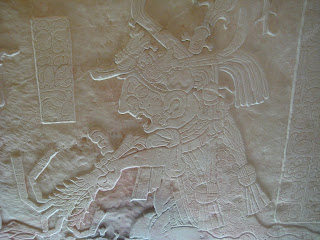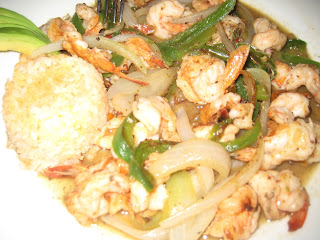Palenque - a modern name for an ancient city in the Chiapas area, is one of the best preserved Mayan sites. Much of it is still believed to be buried within the forest for the trees spread far and wide, covering everything if they get a chance. This empire began around 100 B.C., flourished under the rule of the king Pacal (Sun Shield) and his son Chan Bahlum (Serpent Jaguar) in the 7th and 8th centuries A.D. Its decline began in the 9th century A.D.
This was also one of the first cities to be re-discovered after many centuries. In 1746, a Spanish priest, Padre Solis, was sent by his bishop on an exploratory trip to Santo Domingo de Palenque. He had heard of a buried city and came across impressive remains that lay deep in the forest. After his reports, several explorers visited the area and each contributed and added to the information that is now available about this site.
Pacal ruled Palenque from 615 A.D. to 683 A.D. and constructed a huge 'Palace' complex. This may have served as the home for the royal family (there are buildings with naturally air cooled 'bedrooms' - laid out with a stone bed and ventilation channels, systems for sewage management and also water canals) but the complex may also have served as an area for religious and cultural ceremonies. A large tower rises above the Palace. This is believed to be a watch tower or, more likely, an astronomical observatory.
Near the palace stands the Temple of Inscriptions - a splendidly built structure, tapering in pyramid style, with a flattened top and a central room filled with intricate, carved symbols. For a long time, people had been trying to study this central room, however, in 1952, the Mexican archaeologist Alberto Ruz found that this building contained much more than was apparent to the eye. Hidden by slabs in the floor of the temple lay an entrance to a long staircase. This led to a high ceilinged crypt - a Funerary Crypt that contained a monolithic, highly inscribed and decorated sarcophagus. The inscriptions indicated that this was the tomb of King Pacal.
The Temple of Inscriptions was closed for renovation when we went and I was greatly disappointed, for this is one of the highlights of the archaeological site. I had foolishly avoided visiting a life size model of the tomb at the museum at Mexico City, thinking that I would shortly be seeing the original! Apparently all the contents of the tomb have also been moved to Mexico City - and there were several treasures that it originally contained. An amazingly carved funerary mask of jade with eyes of shell and obsidian had been placed over the face of the king. Two realistic stucco heads, possibly portraits of the king, were placed close by. The lid of the sarcophagus is a complex relief with astronomical symbols, interpreted by scholars to depict the Cosmic Tree (a symbol of the Milky Way) or the 'White Road' along which the spirit of the dead king travelled before it was reborn into a new life. The inscriptions mention that Pacal was succeeded by his son Chan Bahlum, who constructed three great temples in this complex in specific cosmological orientations.
The three temples are the Temple of the Sun, the Temple of the Cross and the Temple of the Foliated Cross. These are also pyramid like structures with flattened tops with roofcombs. The dedicatory ceremony for the Temple of the Cross was celebrated at a time of the year when three planets were in conjunction with the sun.
Most of the inscriptions and several of the reliefs on the temples have been deciphered and copies are seen in the small but well designed site museum.
We also took a short walk in the adjoining forest. Howler monkeys shrieked in the distance and invisible birds called out periodically. Other than that it was quite still. Tree roots clambered over small ancient buildings and temple-like structures. Our guide pointed out trees and plants that were used locally for food, as natural dyes, as medicine. He broke off a large termite mound and rubbed some termites on his skin - this serves as a mosquito repellent. Then he popped some in his mouth. "Delicious! Minty! Try them!" he said and we did. To our surprise they did taste of mint and were rather refreshing.
At the end of a long day we trudged back, negotiated (rather fought over) our return fare and took long, hot baths to wash off all the grime and sweat. We had dinner at El Huachinango Feliz (which roughly translates to 'The Happy Snapper'). This place is packed every evening, with locals and tourists. Prices are reasonable and service is efficient. They serve all kinds of Mexican food but are known for their seafood. Along with our drinks they served a large plate of avocado and small, delicious shrimps witha sprinkling of lemon juice and salt. This was on the house and a perfect beginning to our large meal. It was followed by fish and shellfish, cooked in Mexican sauces and served fresh and piping hot! Then, we somehow managed to walk back to our hotel (a few metres away), climb into bed - and were soon fast asleep.
















No comments:
Post a Comment